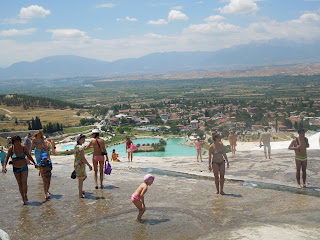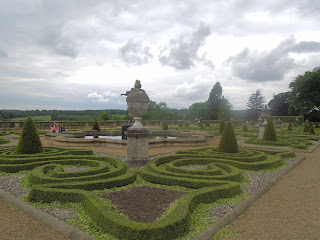On a recent bus trip around Turkey, I sought out public
spaces, finding them in most of the large cities we visited, particularly along
tourist attractions and water fronts (Canakkale, Ismir). And, while tourist economies help fuel visits
to the sidewalk cafes (near the bazars), coffee shops lining prime routes to
public attractions (the Blue mosque in Istanbul) or parks along the water (Ismir),
the locals seemed to provide the foundation for the community life represented
there. People also lived close to most
of these places where street and “village” life exists. Moving away from such spots, the public life
declined and the automobile took over, which you can see leaving Istanbul or Ismir. Even in smaller places, such as Cappadocia,
spreading out the population led to a less visible public life.
Prior to my visit to Istanbul, I was in London, and before
that in Leeds. Both are vibrant cities,
in some places and at some times. This
latter point is often missing. While
Times Square ion New York City may “never sleep,” and similar spots in London
have almost constant life, constant activity is a rarity and we should not
expect to measure the life of our urban area by whether or not public spaces
are constantly inhabited, packed with life.
Leeds, a smaller but quite substantial older city in Yorkshire, Great
Britain, is an example. Built before the
automobile, it has the ambience provided by elegant old buildings and arcades
that connect the streets. Wisely, the
city “fathers” blocked off a couple of connecting streets so that a network of
walkways and pedestrian paths connects the center of the city and attract the
city’s residents and visitors alike.
This is what most cities, large or small, covet in their redevelopment
efforts. The public “investment” is
matched by retail stores and services and professional offices that are
supported in part by an old fashioned public market similar to the West Side
Market in Cleveland—specialized vendors in glorious old buildings and lining
outdoor stalls. In Leeds, the newer
immigrants from across Europe, and Asia, have set up shop in these areas,
providing novelty to accompany British history represented by the original
venue. But visit these public spaces on Sunday morning or late at night, and,
the shops closed, public life recedes into private spaces. Still, it’s an outcome to be sought by other
communities, and, with numerous empty spots in the public market, even here
there’s the hint that retaining this vital public space is a challenge. The
automobile arrived in Leeds long ago too, though this traveler arrived by train
from London.
Back in London, I traveled by bus and by foot, generally the
latter. Doing so, I found myself lost a
couple times as I tried to discover short cuts or decided to do my hour+
morning walk in a different direction. I
must say that London’s age and subsequent decisions have sustained a better
representation of public spaces throughout the center city than I had
expected. But, even here, now and then
the automobile drew people away from such a lifestyle.
This weekend, I returned to Idaho for the first time in five
years, arriving at the Boise airport during a dark, rainy night. Renting a car, I was disoriented in leaving
the area, which has built up so much that I wondered whether the valley had
become one big metro area. A few minutes
later, I encountered a few spots still devoid of commercial activity, but I’m
sure over time these too will fill in as Interstate 84 linking Boise and its
immediate suburbs (Garden City, Meridian) extends to Nampa, and then on to
Caldwell. I visited what passes for “historic”
sites from my youth during my stay. I
had planned to stay at the Sundowner Motel in on 10th Street because
it allowed me to walk around downtown and on to nearby neighborhoods, maybe
even stop for a late beer or glass of wine late at night without using the
rental car. When I came over the bridge
late at night, I found the Sundowner closed, and it was the last surviving
place to stay without returning to the hotels and motels along the
Interstate. Since both of the habitable
motels near Caldwell were booked up, I had to drive on towards Nampa for a
place to stay, returning the second night to the closer Best Western Hotel. And, while five years ago I could find a few
places downtown to have a beer, cup of
coffee or a bite at various hours, this time the central area had become almost
devoid of such private third places. The
next morning I searched and finally found one coffee shop run by some young
folks at the Bird’s Nest who reminded me of local developers in my Cleveland
center city neighborhood. There were a
couple taco/Mexican restaurants and two Chinese restaurants left, but often they
weren’t open. The public investment
downtown was impressive, with considerable funds to uncover Indian Creek,
provide pleasant sidewalks and sitting areas, little parks nestled here and
there. But there was little else to attract
people. The Indian Creek Festival was
held while I was there and it did attract several thousand folks to the area
for a cardboard boat race, food booths, public service tables, face painting
for the kids, etc. but that lasted part of one day. Then they rolled up the sidewalks again. At the class reunion I talked with a fellow
classmate/prominent city father/retired businessman, and he said they were
trying but it was difficult. I suggested
housing above the stores so you could integrate residential with potential
retail, but he said the cost was not attractive to developers. Even the mall between Caldwell and Nampa has
lost its most important anchors—Macy’s & Penney’s—to a mall along the
freeway closer to Boise. I drove over to
downtown Nampa to see if it was faring better but discovered a similar
depressed situation downtown, though it still has a small motel where someone
could stay. Thus, the small town faces
the same obstacles as big city central areas and neighborhoods.
I think people our literature promoting third places and
vibrant public spaces is actually a search for community. While the village life persists in more rural
areas, perhaps, and also exists in urban areas when density, important
“destinations” and attracting public spaces coalesce, it’s an elusive goal in
an automobile culture. Even more rural Cappadocia
was beginning to spread out with development to serve the tourists, so our
hotel was distant in walking terms from such public spaces. Only
when constrained by history and geography do communities manage to maintain a
walking culture over time.
I think we need to look at public spaces less as a cure for
what ails communities and as an ingredient that needs to be integrated
thoughtfully in planning and sometimes abandoned as impractical. I still hope Leeds retains the life in its
marvelous public market and doesn’t lose businesses in the less traveled areas
of its arcades, and it’s likely to be a struggle as people move more towards
the outskirts. One key is integration,
not just of people, but of functions.
Delightful public spaces should be developed for the locals, and then
attract tourists as an added benefit (with exceptions of course in major
tourist destinations). That means we
need residential areas integrated with public spaces, shopping with living,
public with private services, uses needed by the old and services attracting
the young. I remember years ago an
architect noting that single-purpose neighborhoods force people to “move” as they
progress through the life cycle. A
suburb with large homes and no apartments provides no place to downsize. Old neighborhoods with houses filled by
families with 12 kids a century ago had to be converted to multiple apartments
to survive, so it’s not a new occurrence.
Perhaps we need to revisit the concept behind the “7-mile
town” that I recall studying in my geography class a half century ago. When man traveled by horse, a town, or stop
of some sort was needed about every seven miles. Thus, many rural areas are dotted with the
remnants of such 7-mile towns. On my
last trip to Nebraska, Bayard, the community near where I was born and went to
school illustrates this. Bridgeport, the
county seat of Morrill County in western Nebraska has fared better because it
still has a “reason for being,” the government offices an courthouse. Some 15 or so miles away, Bayard, has no such
“reason,” having lost its sugar beet factory and almost all of its retail
establishments, leaving a bedroom community of folks who now travel the highway
to Sottsbluff for their commercial needs. In between are other small 7 mile
towns, or corner stops equivalent to convenience stores in cities today, e.g., Moomaw
Corners (wiped off the map), Minatare, with a bar or two). The automobile eliminated the “need” to
settle, or stop, in such places.
I wonder if we need to ask whether there’s a distance
between “needed” third places or public spaces for congregating. And how do we learn what these distances
are. When I was a graduate student at
the University of Washington in Seattle in the late 1960s, the university had
given up on trying to get students to walk where they wanted them to, on
concrete sidewalks planned to connect buildings in an aesthetic manner. So,
when students (and probably a few faculty too) wore a new path through the
grass or dirt, they laid down a patch of asphalt. Thus, the network looked like patchwork, but
it did work, meeting the needs of students, who knew where they wanted to go
and didn’t need it “planned” for them.
Maybe this scenario could work for designing third places in urban
areas, particularly when buildings are demolished and vacant lots start to dot
the landscape. When people “loiter,”
they are asking for a public space for congregating. When a group decides a vacant lot would be a
good garden, given permission or not, they’re seeking not just vegetables and
cheap food but a place to create community within their physical
community. There have to be other, additional strategies
for making the decisions, and such a combination of “bottom up/grassroots”
indicators and “top down/planning-and-communication theory” might just fit the
bill. We always need to remember that
the quest for community is a search not only for a sense of belonging but also
for a communication network, however big or small it is.




































